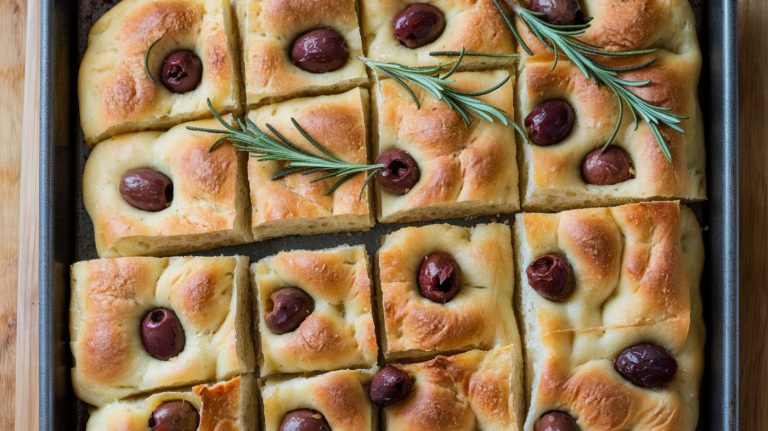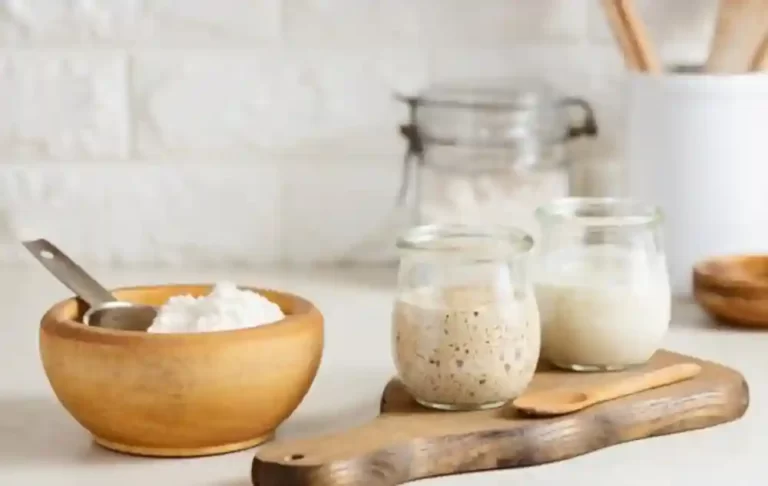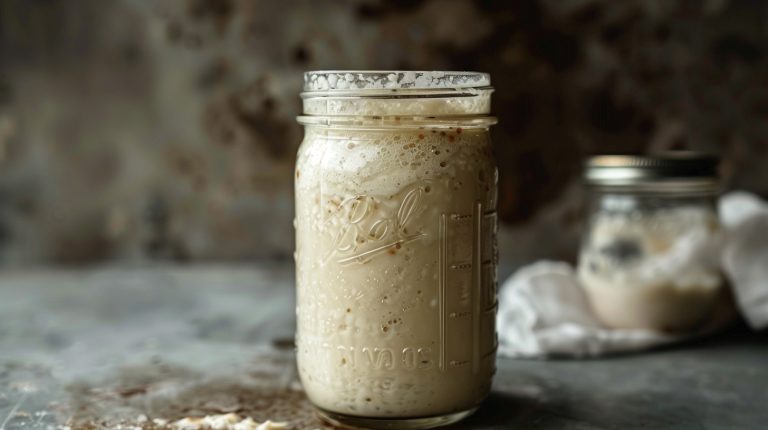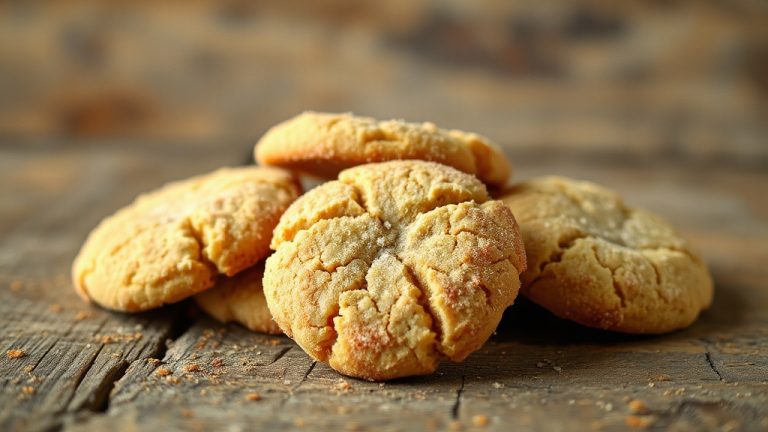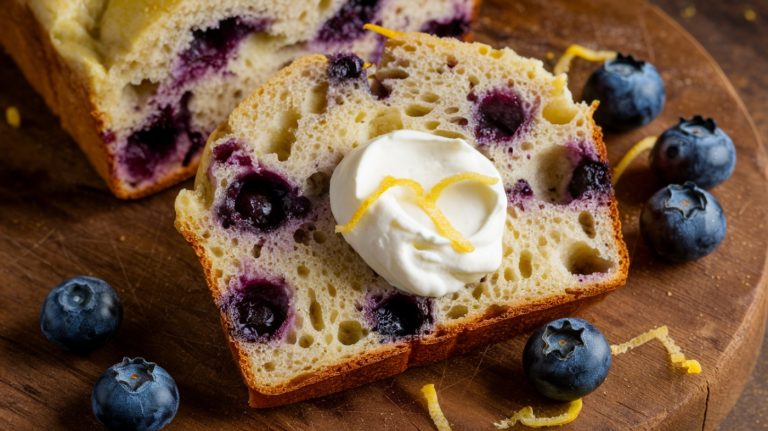Sourdough Discard Dutch Baby: Crisp, Airy, Incredibly Delicious
You can turn your sourdough discard into a Dutch baby by whisking it with eggs, milk and melted butter for structure and richness. Preheat a cast iron skillet at 450°F to guarantee even heat and crisp edges, then pour in the batter immediately for maximum puff.
Bake 15–20 minutes without opening the oven. This method keeps your starter healthy and creates a deliciously airy pancake. Explore tips on toppings, reheating, and storage to perfect your dish.
Key Takeaways
- Sourdough discard adds tangy flavor and natural leavening to Dutch baby batter, enhancing rise and texture.
- Combine discard with eggs, milk, flour, and melted butter; whisk until smooth without overbeating for optimal puff.
- Preheat a cast iron skillet to 450°F, melt butter in it, then pour batter immediately for crisp edges and height.
- Bake 15–20 minutes without opening the oven to preserve the Dutch baby’s airy, puffed structure and golden crust.
- Serve warm from the skillet with sweet or savory toppings; reheat leftovers in the oven to maintain crispness.
Easy Sourdough Dutch Baby Recipe Table
| Ingredients | Process |
|---|---|
| 120g sourdough discard (unfed starter) | Ensure discard is at room temperature for smooth mixing |
| 4-6 large eggs (room temperature) | Whisk eggs thoroughly until well combined before adding other ingredients |
| 120g whole milk (room temperature) | Add milk gradually while whisking to prevent lumps |
| 60g all-purpose flour | Sift flour to avoid lumps, then whisk into wet ingredients |
| 60g melted butter (divided) | Melt butter and let cool slightly. Use half in batter, reserve half for skillet |
| 1 tsp vanilla extract (optional) | Add to wet ingredients for enhanced flavor |
| 1/2 tsp cinnamon (optional) | Mix with dry ingredients for warm spice notes |
| Pinch of salt | Enhances overall flavor balance |
Essential Ingredients for Your Dutch Baby
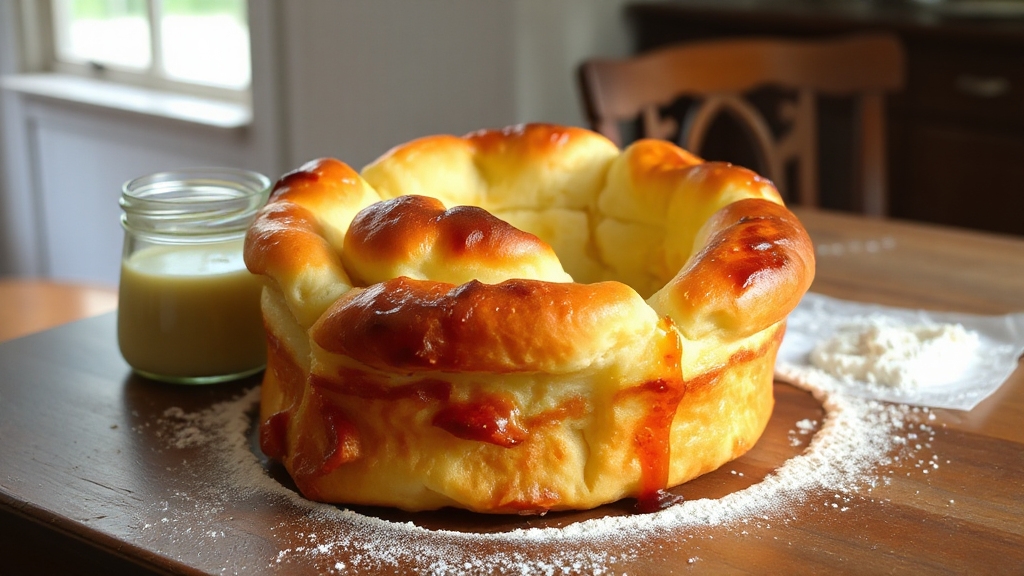
To create a tender, well-risen Dutch baby, you’ll combine your sourdough discard starter with 2-3 large eggs, which provide essential structure and leavening.
Dutch babies are known for their large, puffy, and light texture when baked properly, which is achieved without traditional leavening agents like baking powder or baking soda. Whole milk contributes moisture and richness, balancing the batter’s consistency for a smooth pour.
Using a skillet with proper airflow ensures even heat distribution and helps maintain the crisp edges of the Dutch baby. Finish by melting about 2 tablespoons of butter in your skillet to guarantee a crisp, flavorful edge and ideal browning during baking. This method ensures your Dutch baby has the characteristic large, puffy texture that distinguishes it from regular pancakes.
Starter and Eggs
When you combine sourdough starter with eggs in your Dutch baby batter, you create a delicate balance of fermentation and protein structure that drives the dish’s signature rise and texture. The starter, whether active or discard, introduces natural yeast and lactic acid bacteria, contributing mild tang and leavening power.
Eggs supply high-quality protein that coagulates upon baking, stabilizing the batter and trapping expanding air pockets. Using large, room-temperature eggs ensures smooth incorporation and ideal emulsification with the starter.
Typically, 4 to 6 eggs balance the liquid starter, preventing a runny or overly stiff batter. Whisk eggs thoroughly before folding in starter gently to preserve aeration.
This synergy of starter’s fermentative activity and eggs’ protein matrix creates the Dutch baby’s dramatic oven spring and tender crumb without chemical leaveners. For best results, proofing your sourdough starter in a natural rattan basket can enhance its fermentative activity and flavor development.
Milk and Butter
Milk and butter play critical roles in the structure and flavor of your sourdough discard Dutch baby. Whole milk contributes moisture and fat, hydrating the flour and starter for ideal batter texture and promoting tenderness and browning. Using high-quality butter, preferably homemade if possible, enhances the overall richness and flavor of the finished pancake.
Butter, melted and partially incorporated into the batter, adds richness, tender crumb, and creates crispy edges via its milk solids and fats. Both ingredients should be at room temperature to guarantee smooth mixing and maximum rise.
- Use about 120 g whole milk and 60 g melted butter for balanced moisture and fat.
- Melt half the butter into the batter; reserve the rest to grease the pan for easy release and flavor.
- Room temperature milk prevents uneven texture and promotes puffiness.
- Butter caramelization during baking enhances crust flavor and crispness.
- Remember that a hot cast iron skillet is essential to achieve the signature puffiness and quick baking of a Dutch baby.
Step-by-Step Preparation and Cooking Tips
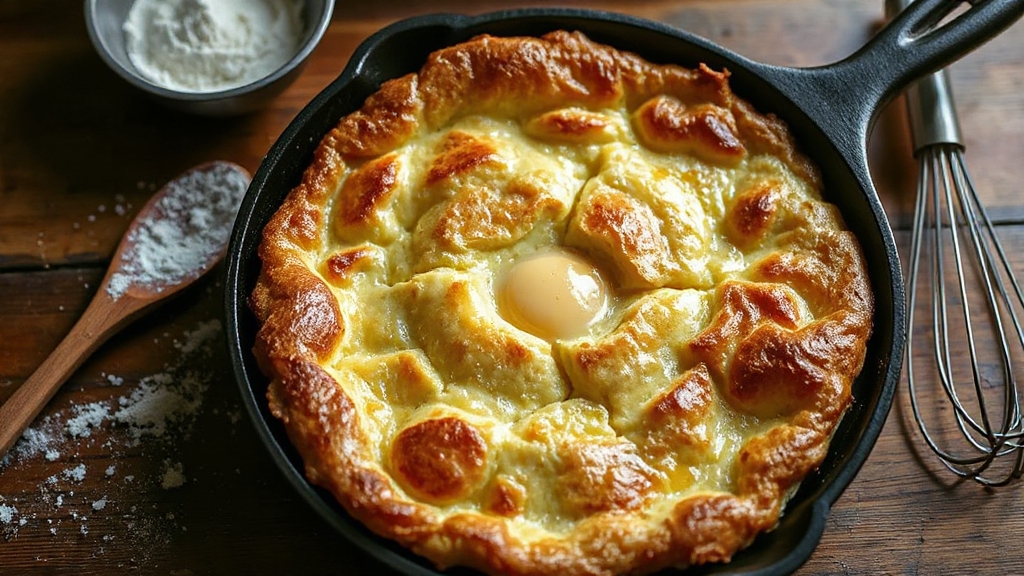
Although achieving the perfect Dutch baby requires attention to detail, mastering the preparation and cooking steps guarantees ideal rise, texture, and flavor.
Start by whisking room temperature eggs, whole milk, and precisely weighed flour with sourdough discard, adding vanilla or cinnamon if desired—mix just until smooth without overbeating. Using fresh eggs less than a week old can significantly improve the rise and texture of your Dutch baby.
Preheat your oven to 450°F (232°C), placing a 10–12 inch cast iron skillet inside to heat thoroughly.
Melt butter in the hot skillet, then immediately pour in the batter to initiate rapid puffing.
Bake uninterrupted for 15–20 minutes; avoid opening the door to preserve the dramatic rise and crisp edges.
Once baked, let it cool slightly before serving to stabilize structure.
For thicker or thinner results, adjust skillet size accordingly.
These steps ensure a balanced, tender center with a golden, crispy crust.
Creative Toppings and Flavor Variations
Since the Dutch baby’s tender, airy base offers a versatile canvas, you can elevate markedly by selecting creative toppings and flavor variations. You’ll want to balance flavors and textures to complement the sourdough’s subtle tang.
- Sweeten with fresh berries combined with whipped cream or dust with powdered sugar for a light, invigorating contrast.
- Incorporate warm spices like cinnamon and vanilla extract directly into the batter to enhance aromatic complexity, ensuring the batter is rested for 10 minutes to develop gluten and aid puffing.
- For savory profiles, top with smoked salmon and cream cheese or sautéed spinach with fresh herbs to add depth and freshness.
- Experiment with texture by adding melted cheese or crunchy nuts atop, creating contrasts between crisp edges and creamy or crunchy elements.
These variations maximize flavor while maintaining the Dutch baby’s characteristic delicate structure.
Choosing the Right Cooking Vessel
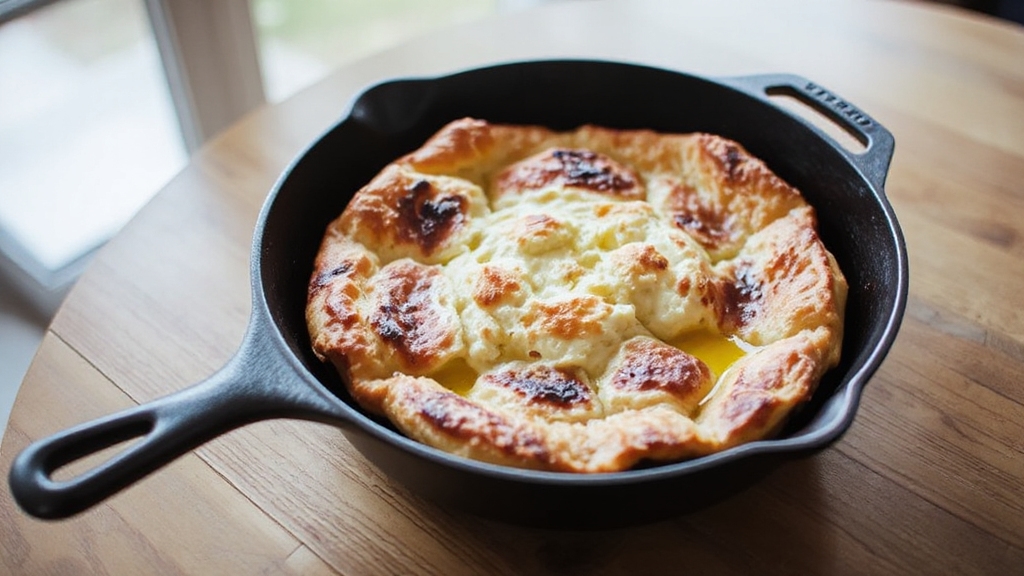
When selecting a cooking vessel for your sourdough Dutch baby, you’ll want to prioritize materials and shapes that promote even heat distribution and can withstand high oven temperatures. Cast iron skillets excel here, offering superior heat retention and crisp edges. Using a cast iron skillet with a long handle can also improve safety and handling during baking.
Ceramic or glass dishes heat slower and may soften edges, while muffin tins yield smaller puffs and more crust area. Preheating the vessel is key to maximizing rise and crust texture.
Choose a 9-12 inch diameter for ideal batter volume; deeper pans reduce puff height but hold more batter. Although preheating the pan with butter is discouraged, using ghee or coconut oil allows you to preheat safely while maintaining good texture.
Serving Suggestions and Storage Guidelines
You’ll want to serve your sourdough discard Dutch baby warm to maintain its delicate puff and texture, pairing it with either sweet toppings like fresh berries or savory options such as smoked salmon.
Using a cast iron skillet is recommended for even cooking and optimal rise, ensuring the best texture and flavor. To keep your Dutch baby fresh longer, consider storing it in linen bread bags which help maintain moisture and prevent spoilage.
If you have leftovers, store them in an airtight container in the refrigerator and reheat using an oven to restore crispiness without sogginess. For quicker reheating, microwaving is possible but may alter the texture and taste.
For best results, consume within two days or freeze portions tightly wrapped for up to a month, noting that texture may slightly change after thawing. Using eco-friendly storage options like reusable linen bags supports sustainable kitchen practices and reduces plastic waste.
Ideal Serving Ideas
How can you elevate your sourdough discard Dutch baby to a memorable dish? Focus on balanced toppings, complementary sides, presentation, and serving temperature. Here’s how:
- Combine fresh berries or sautéed mushrooms with a drizzle of maple syrup or a sprinkle of grated cheese to contrast sweet and savory notes precisely.
- Serve directly from the hot cast iron skillet to maintain exemplary puffiness and crisp edges, enhancing texture.
- Pair with crisp breakfast potatoes or a light fruit salad to balance richness and add textural variety.
- Reheat gently in an oven or skillet—avoid microwaving—to restore the Dutch baby’s signature airy structure without compromising texture.
These steps ensure your dish retains its ideal visual appeal, flavor complexity, and mouthfeel, delivering an elevated dining experience every time. For home cooks looking to perfect crust and texture, incorporating Dutch Oven techniques can further enhance your Dutch baby’s quality.
Storing Leftover Dutch Baby
After savoring your perfectly served sourdough discard Dutch baby, managing any leftovers properly guarantees you can enjoy its delicate texture and flavor later.
Store leftovers in airtight glass or food-grade plastic containers with tight-fitting lids within 2 hours of cooking to prevent bacterial growth and drying. Avoid stacking to preserve texture. Since sourdough discard contains natural wild yeast and bacteria, it can continue fermenting subtly even after cooking, influencing flavor if stored improperly (natural fermentation).
Refrigerate up to 3–5 days, labeling containers with the date. For reheating, preheat your oven to 350°F (175°C) and heat uncovered for 8–10 minutes to restore crisp edges; microwaving is possible but softens texture.
Freezing is discouraged due to texture loss; if necessary, wrap tightly and freeze no longer than 1 month, thawing overnight in the refrigerator.
Always discard if off smells, discoloration, or sliminess develop.
Keep toppings separate until serving to maintain ideal freshness.
Frequently Asked Questions
Can I Use Sourdough Discard That Has Been Refrigerated for Several Days?
You can definitely use sourdough discard refrigerated for several days. Refrigeration slows fermentation but doesn’t stop it, so the discard remains viable within 2-3 weeks.
Just stir it to reincorporate any separated liquid and check for off smells or mold before use. Its acidity will increase over time, so it’s best suited for non-yeasted recipes where active rising isn’t essential.
Using it promptly ensures ideal flavor and texture.
How Does the Hydration Level of the Discard Affect the Dutch Baby Texture?
Hydration heavily hones how your Dutch baby develops texture. Higher hydration—meaning more water—yields a lighter, loftier, and airier crumb with a thinner crust, thanks to increased moisture and steam.
Lower hydration, with less water, produces a denser, firmer bite and a thicker crust.
You’ll notice higher hydration batters spread fluidly, promoting puffiness, while lower hydration batters are stiffer, resulting in less rise and a chewier crust.
Is It Possible to Make a Gluten-Free Sourdough Discard Dutch Baby?
Yes, you can make a gluten-free sourdough discard Dutch baby. Use gluten-free flours like tapioca, potato starch, or brown rice flour for the discard and batter.
Blend these with eggs, dairy or plant-based milk, and fat to achieve the right batter consistency—pourable yet slightly thick.
Preheat your pan thoroughly and bake at high heat for a proper puff and caramelization.
This yields a tender, custardy texture with crisp edges, despite lacking gluten.
Can I Double the Recipe Without Changing Baking Time or Temperature?
Doubling your recipe is like adding layers to a symphony; it demands more attention. You shouldn’t keep baking time or temperature unchanged because increased batter volume slows heat penetration.
Preserve the oven temperature around 465°F (240°C), but expect to extend baking time incrementally—typically by 3-5 minutes. Use a larger preheated pan for even heat distribution, and monitor doneness visually or with a toothpick to ensure thorough cooking without compromising rise or texture.
What Causes the Dutch Baby to Deflate Quickly After Baking?
The Dutch Baby deflates quickly because steam, created from rapidly heated eggs and milk, inflates its structure during baking. Once removed from the oven, steam escapes, and the puff loses internal pressure, causing collapse.
Its thin walls and lack of chemical leaveners mean it relies entirely on steam, which dissipates fast as it cools. To maintain puff, serve immediately and avoid cutting or cooling outside the oven.
From Simple to Spectacular—Let Your Dutch Baby Shine
By mastering sourdough discard Dutch baby, you turn kitchen scraps into a golden opportunity for deliciousness. With precise measurements and careful timing, you’ll achieve that perfect puff—light, airy, and crisp.
Remember, the right pan and creative toppings can elevate your creation from simple to spectacular. Keep experimenting, because every batch is a fresh canvas, and your Dutch baby will rise like a well-tuned symphony, blending science and flavor flawlessly.


